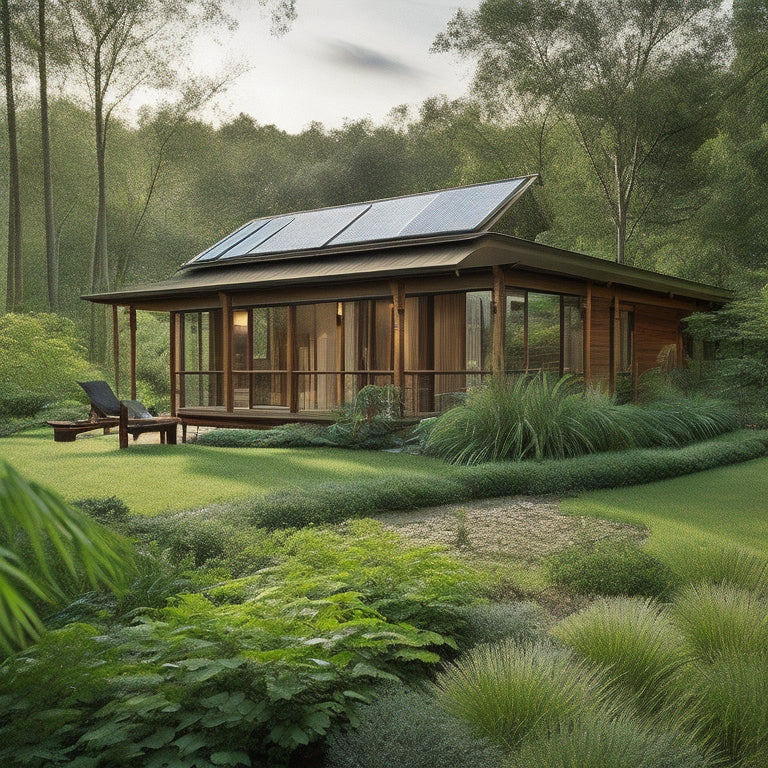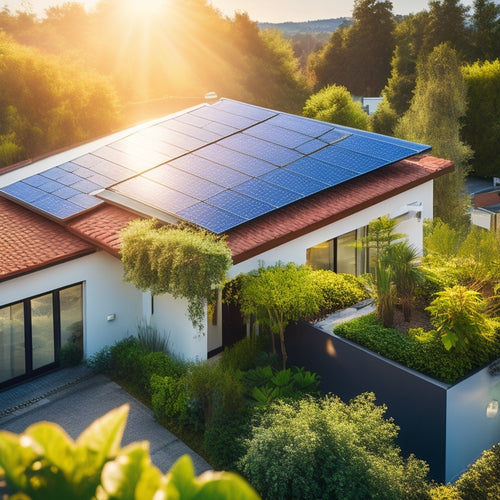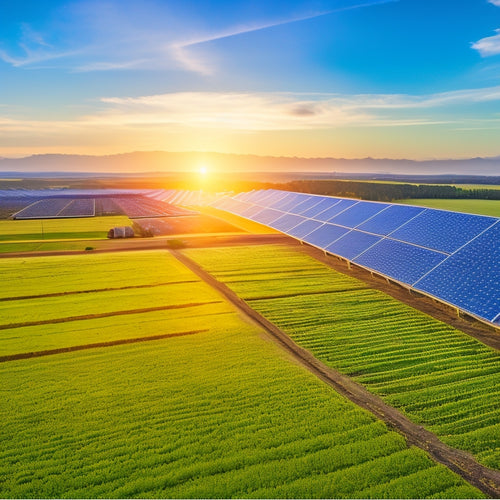
Affordable Sustainable Building Materials for Homes
Share
You can build an eco-friendly home on a budget by choosing affordable sustainable materials. Consider using reclaimed wood, bamboo, or recycled steel to enhance your home's durability and reduce waste. Upcycling old furniture and shopping at thrift stores not only saves money but also promotes creativity. Local sourcing lowers transportation costs and supports your community, while energy-efficient insulation cuts back on utility bills. By incorporating these materials, you'll reflect your values and contribute to a healthier planet. There's plenty more to investigate on how these choices can shape a sustainable living space for you.
What You Need to Know
- Recycled materials, such as reclaimed wood and upcycled furniture, reduce costs and enhance sustainability for affordable home building.
- Local sourcing minimizes transportation emissions and supports the community, leading to better pricing and regional pride.
- Energy-efficient insulation options, like recycled denim and cellulose, significantly lower heating and cooling costs over time.
- Incorporating renewable energy sources, such as solar panels, can lead to substantial long-term savings on utility bills.
- Durable materials, like bamboo and metal, offer longevity, reducing the need for replacements and overall resource consumption.
Eco-Friendly and Cost-Effective
When you're looking to build sustainably without breaking the bank, consider using recycled materials that not only cut costs but also reduce waste.
Eco-friendly attributes of materials like rattan and bamboo can enhance your project's sustainability.
Local sourcing can enhance your project by supporting the community and minimizing transportation emissions.
Recycled Material Options
Recycled materials are often overlooked but can be a life-changing factor in sustainable building. By opting for reclaimed wood, you not only add character to your home but also reduce waste and minimize your carbon footprint. Each piece tells a story, bringing warmth and a unique aesthetic that new materials just can't replicate.
Choosing materials like reclaimed wood aligns with the principles of eco-friendly materials, emphasizing sustainability in every aspect of your home.
When you're considering upcycled furniture, think about how you can breathe new life into old pieces. It's not just about saving money; it's about welcoming creativity and individuality in your space. You can find extraordinary items at thrift stores or garage sales, or even revitalize old furniture with a fresh coat of paint and new hardware.
Using recycled materials allows you to create a home that reflects your values. You'll enjoy the freedom of designing a space that's not only beautiful but also sustainable. Plus, you'll inspire others to think outside the box and make eco-friendly choices.
Local Sourcing Benefits
Local sourcing can convert your building project into an eco-friendly triumph. By choosing materials from nearby suppliers, you not only minimize transportation emissions but also support your local economy. This approach encourages community engagement, allowing you to connect with your neighbors and create a resilient network of artisans and businesses.
Here's a quick comparison of local sourcing benefits:
| Benefits | Description |
|---|---|
| Eco-Friendly | Reduces carbon footprint due to shorter transport distances. |
| Cost-Effective | Lowers shipping costs and often leads to better pricing. |
| Community Engagement | Strengthens local ties and promotes regional pride. |
| Supports Local Economy | Keeps money within the community, nurturing growth. |
Long-Term Savings on Energy
When you choose energy-efficient insulation options, you're not just enhancing comfort; you're also slashing your energy bills.
Integrating sustainable materials, such as eco-friendly finishes, can further increase your savings and reduce your carbon footprint.
Additionally, integrating renewable energy solutions can further increase your savings and reduce your carbon footprint.
Let's investigate how these choices can lead to significant long-term financial benefits while promoting a healthier planet.
Energy-Efficient Insulation Options
Choosing energy-efficient insulation options can greatly reduce your long-term energy costs while enhancing your home's comfort. When you think about insulation, consider materials that not only provide excellent thermal resistance but also align with your eco-friendly values.
For example, energy efficiency fundamentals emphasize the importance of high thermal mass materials, which effectively regulate indoor temperature. Integrating a green roof can greatly enhance your insulation by reducing heat absorption and offering natural thermal mass. This innovative design keeps your home cooler in the summer and warmer in the winter, leading to substantial energy savings over time.
You might also investigate recycled insulation materials, like denim or cellulose, which provide outstanding thermal performance without harming the environment. These materials help maintain a balanced indoor temperature, reducing the need for heating and cooling systems, which can be a major drain on your budget.
Additionally, consider using insulated concrete forms (ICFs) or structural insulated panels (SIPs) that offer superior insulation properties and durability.
Renewable Energy Integration
Integrating renewable energy sources into your home not only promotes sustainability but also leads to significant long-term savings on energy costs. By accepting solar panel integration, you utilize the sun's power, converting it into free electricity. Imagine slashing your utility bills while contributing to a cleaner planet.
With advancements in technology, solar panels have become more efficient and affordable, making them a practical choice for every homeowner. Additionally, commercial solar power offers financial benefits that can be advantageous for residential users as well, particularly in reducing overall energy expenses.
Wind energy solutions also offer incredible potential. If you live in an area with consistent winds, installing a small wind turbine can generate additional energy, further reducing your reliance on traditional power sources.
This combination of solar and wind energy creates a diversified energy portfolio that enhances your energy independence. As you accept these eco-friendly options, you not only save money but also gain the freedom to control your energy consumption.
With renewable energy, you're investing in a sustainable future, ensuring that your home isn't just a place to live but a lighthouse of innovation. So, take the leap and integrate renewable energy today—your wallet and the planet will thank you for it!
Material Durability and Performance
When choosing sustainable materials, you'll want to evaluate their lifespan and overall performance.
Not only can durable materials save you money over time, but they also lessen your environmental impact by reducing waste.
Let's examine how these factors play an essential role in your building decisions.
Lifespan of Materials
Many sustainable building materials boast impressive lifespans, making them reliable choices for eco-conscious construction projects. When you choose materials with high material longevity, you're investing in your home's future. Options like reclaimed wood, bamboo, and recycled metal can last decades with minimal wear and tear, reducing the need for frequent replacements.
It's crucial to keep maintenance considerations in mind, though. Regular upkeep can greatly extend the life of your materials. For example, sealing and treating wooden surfaces can prevent rot and decay, while proper insulation can help maintain energy efficiency over time.
With a little effort, you can guarantee your sustainable choices remain functional and visually appealing for years to come.
Environmental Impact Assessment
Evaluating the environmental impact of building materials involves examining their durability and performance over time. You want materials that not only stand the test of time but also align with sustainability metrics to minimize your ecological footprint. By choosing durable materials, you reduce the need for frequent replacements, which cuts down on waste and resource consumption.
Think about how materials interact with their environment. For instance, bamboo and reclaimed wood offer exceptional durability while sequestering carbon, making them excellent choices for eco-conscious builders. Similarly, choosing high-performance insulation can enhance energy efficiency, keeping your home comfortable and reducing reliance on heating and cooling systems.
When evaluating the longevity of materials, consider their lifecycle—from extraction to disposal. Innovative materials like recycled steel and hempcrete are gaining traction, as they provide both structural integrity and sustainability. By factoring in these elements, you not only guarantee your home remains resilient but also contribute positively to the planet.
Ultimately, your choice of materials can enable you to create a living space that reflects your values while promoting a healthier environment. Seize this opportunity to make informed decisions that connect with your desire for freedom and sustainability.
Assessing Environmental Impact
When choosing sustainable building materials, it's crucial to evaluate their entire life cycle, from production to disposal.
You'll want to look closely at sourcing practices, ensuring they align with eco-friendly standards.
Life Cycle Assessment
Understanding the life cycle assessment (LCA) of building materials can change how you approach sustainable construction. By evaluating the environmental impact of materials from extraction to disposal, you can make informed choices that enhance sustainability metrics. This comprehensive view allows you to appreciate not just the initial costs but the long-term effects on our planet.
As you investigate material innovation, consider how different choices can minimize waste and reduce carbon footprints. For instance, materials that require less energy to manufacture or those sourced from renewable resources can greatly lower your project's overall impact.
You'll find that innovative materials often blend performance with eco-friendliness, giving you the freedom to create spaces that reflect your values.
Incorporating LCA into your decision-making process enables you to choose wisely. It's about more than just aesthetics; it's about creating a legacy of sustainability. By prioritizing materials with a lower environmental footprint, you're not just building a home—you're contributing to a healthier planet.
Material Sourcing Practices
Sourcing materials sustainably isn't just an afterthought; it's an essential step in minimizing your project's environmental impact. By adopting effective sourcing strategies, you can guarantee that your building materials aren't only affordable but also eco-friendly.
Start by identifying ethical suppliers who prioritize sustainability in their practices. These suppliers often use renewable resources, recycled materials, and environmentally friendly production methods.
When you choose materials, consider their origin and how they're harvested. Look for local options to reduce transportation emissions and support the community. Investigating a supplier's certifications can also help you assess their commitment to sustainable practices.
You've got the power to make a difference through your choices. Opt for materials that have lower carbon footprints and longer life spans, such as reclaimed wood or bamboo. These not only add character to your home but also contribute to a healthier planet.
Lower Carbon Footprint Overall
When you choose eco-friendly materials for your building projects, you're making a significant impact on your overall carbon footprint.
These innovative options not only reduce emissions during production but also promote sustainability throughout their lifecycle.
Eco-friendly Material Choices
Eco-friendly material choices play a crucial role in reducing the overall carbon footprint of your building projects. When you opt for natural fibers like hemp or jute, you're not just choosing stylish, durable options; you're also making a significant impact on the environment.
These materials require less energy to produce, and their renewability guarantees you're supporting sustainable practices.
Incorporating sustainable finishes, such as low-VOC paints and finishes made from recycled materials, allows you to maintain aesthetic appeal without compromising health or the planet.
These finishes reduce harmful emissions, creating a healthier living space for you and your loved ones.
Think about the long-term benefits of using these innovative materials. By investing in eco-friendly choices, you're not only lowering your carbon footprint but also enhancing the quality and longevity of your home.
You gain freedom from the guilt of harming the environment and the satisfaction of creating a space that reflects your values.
Ultimately, embracing eco-friendly materials gives you the ability to build a sustainable future, one project at a time.
Frequently Asked Questions
What Are the Best Sustainable Materials for DIY Home Projects?
For your DIY home projects, consider using recycled wood, bamboo flooring, and sustainable tiles. Pair them with eco-friendly insulation, reclaimed bricks, natural paints, solar panels, and green adhesives to create a truly innovative, eco-friendly space.
How Can I Source Affordable Sustainable Materials Locally?
You can source affordable sustainable materials locally by exploring community resources like salvage yards, local markets, and eco-conscious suppliers. Connecting with neighbors and attending workshops can also inspire innovative ideas and practical solutions for your projects.
Are There Any Grants for Using Sustainable Building Materials?
Ever dreamt of tapping into hidden treasure? You can investigate various funding sources for grants aimed at sustainable projects. Check grant eligibility requirements, and you might just fund your eco-friendly vision without breaking the bank!
What Are the Most Common Misconceptions About Sustainable Building Materials?
You might think eco-friendly materials are too expensive or less durable. Myth debunking reveals they're often cost-effective and resilient. Embracing these truths enables you to make informed choices for a sustainable, liberated future.
How Do I Maintain Sustainable Materials for Longevity?
Imagine a garden thriving under your care; that's how you'll nurture your sustainable materials. Regular cleaning, proper storage, and eco-friendly practices like sealing can guarantee material maintenance, giving your home the longevity it deserves.
Explore More
By choosing affordable sustainable building materials, you're not just constructing a home; you're planting a seed for a greener future. Each eco-friendly choice is a drop in a vast ocean, rippling through your community and beyond. As you welcome durability and energy efficiency, envision your home as a sturdy tree, roots deep in the earth, flourishing with a lower carbon footprint. Together, let's build a legacy of harmony between comfort and nature, where every brick tells a story of sustainability.
Related Posts
-

Solar Power Systems for Cost-Effective Sustainability
Investing in solar power systems is a smart move for cost-effective sustainability. You can save about $1,500 annuall...
-

Solar Power for Reducing Carbon Footprint
Solar power is an effective strategy for reducing your carbon footprint. By adopting solar energy, you can cut greenh...
-

Integrating Smart Technology for Energy Savings
Integrating smart technology into your home is a transformative factor for energy savings. Smart thermostats give you...


